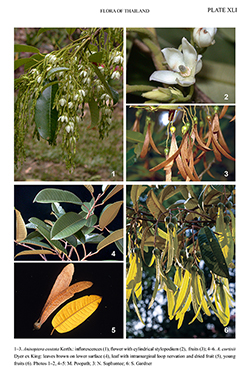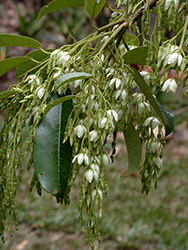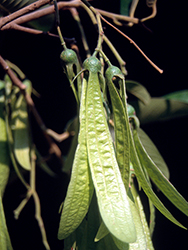e-Flora of Thailand
Volume 13 > Part 4 > Year 2017 > Page 562 > Dipterocarpaceae > Anisoptera
1. Anisoptera costata Korth.wfo-0000537347
Verh. Nat. Gesch. Ned. Bezitt., Bot. 65: t. 6. 1841; Pierre ex Laness., Pl. Util. Col. Franc.: 298. 1886; Smitinand, Santisuk & Phengklai, Thai Forest Bull., Bot. 12: 20. 1980; P.S.Ashton, Fl. Males., Ser. 1, Spermat. 9: 330. 1982; Smitinand, J.E.Vidal & P.H.Hô, Fl. Cambodge, Laos & Vietnam 25: 13. 1990; Svengs. & J.E.Vidal, Diptérocarp. Laos: 9. 1997; Pooma & M.F.Newman, Thai Forest Bull., Bot. 29: 113. 2001; Symington, P.S.Ashton & S.Appanah, Malayan Forest Rec. 16: 431. 2004; Gardner, Sidisunthorn & Chayamarit, Forest Trees S. Thailand Vol. 1: 412, fig. 639. 2015. Plate XLI: 1–3.
Accepted Name : This is currently accepted.
Synonyms & Citations :
Description : Tree to 50 m tall. Indumentum brownish-green to pale yellow peltate scales and shortly fine tufted tomentose hairs on young twigs, buds, stipules, lower surface of leaves, inflorescences, bracts and calyx. Stipules oblong to lanceolate, 0.7–1 cm long. Leaves elliptic to oblong, 2.5–19 by 1.5–10 cm; base broadly cuneate, rounded to slightly cordate; apex shortly acuminate or rounded with abrupt tip; secondary nerves 12–25 on each side, distinctly forming an intramarginal loop, slightly raised above, prominent below; tertiary nerves moderately scalariform; midrib depressed above; petioles 1–2.5 cm long, pubescent. Inflorescences 2–18 cm long, irregularly branched; branchlets 1–4 cm long, bearing 2–5 flowers; bracteoles 3–4 mm long; flower buds ovoid, 0.5–1 cm; pedicels 2–5 mm long. Calyx lobes deltoid, 2–3 by 1.5–2 mm. Petals oblong with obtuse apex, 7–10 by 3–5 mm, white, cream or yellow, sparsely pubescent outside. Stamens 22–34; filaments to ca 0.5 mm long; anthers oblong, to ca 1 mm long; connective-appendages filiform, 2–4 times as long as anthers. Ovary with stylopodium, cylindrical, ca 3 by 1 mm, slightly constricted below the middle, densely short tomentose; style ca 0.5 mm long, deeply trifid with minute stigma. Fruiting calyx tube densely pubescent to glabrescent; 2 longer lobes 5–15 by 1–2 cm; 3 smaller lobes 0.5–2.5 by 0.2–0.7 cm; fruit pedicels 2–5 mm long. Nut 1–1.5 cm in diam., pubescent; stylopodium remnant conical, apiculate to ca 5 mm long.
Thailand : NORTHERN: Lampang, Phrae, Phitsanulok, Tak, Kamphaeng Phet; NORTH-EASTERN: Phetchabun, Udon Thani, Nong Khai, Bueng Kan, Sakon Nakhon, Nakhon Phanom, Mukdahan; EASTERN: Buri Ram, Surin, Roi Et, Si Sa Ket, Ubon Ratchathani; SOUTH-WESTERN: Uthai Thani, Kanchanaburi; SOUTH-EASTERN: Sa Kaeo, Prachin Buri, Chachoengsao, Chon Buri, Chanthaburi, Trat; PENINSULAR: Chumphon, Ranong, Surat Thani, Phangnga, Phuket, Trang, Satun.
Distribution : Myanmar, Laos, Cambodia, S Vietnam, Peninsular Malaysia, Borneo (type), Sumatra, Java, the Philippines.
Ecology : Dry evergreen to evergreen forests, lowland to hillsides, to ca 700 m alt., locally abundant in North-eastern areas. Flowering and fruiting throughout the year.
Vernacular : Krabak (กระบาก), bak (บาก), krabak khao (กระบากขาว); tabak (ตะบาก)(Lampang); krabak khok (กระบากโคก)(Phitsanulok, Si Sa Ket); pra-dik (ประดิก)(Khmer-Surin); phanong (พนอง)(Chanthaburi, Trat); krabak cho (กระบากช่อ), krabak dang (กระบากด้าง), krabak dam (กระบากดำ), krabak daeng (กระบากแดง)(Chumphon, Ranong).
Notes: The number of stamens in Thai specimens was found to be in the range 22–34 while Svengsuksa & Vidal (1997) report a range of 20–55 in Lao material.



